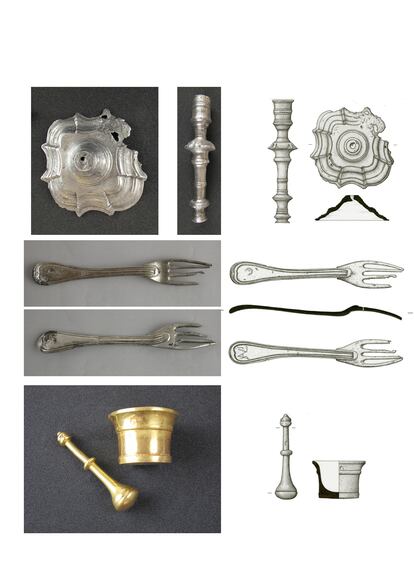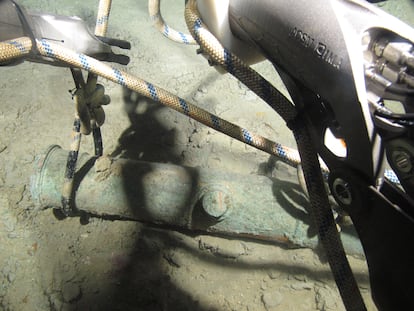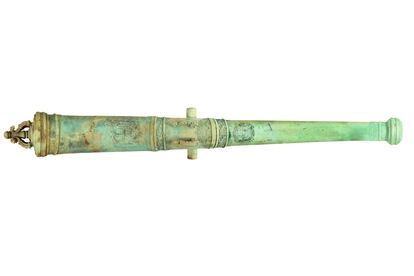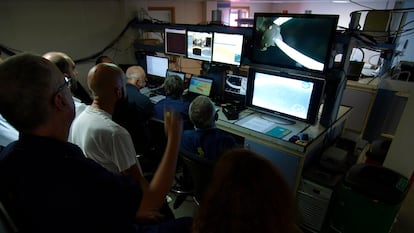Spanish archaeologists recover new treasure from famed ‘Mercedes’ shipwreck
Thousands of artifacts, including bronze cannons, silverware and candelabras, have been excavated from the frigate which made headlines after a US treasure hunting company removed 600,000 coins from the wreck

On October 5, 1804, 30 nautical miles from Cape Santa Maria, Portugal, the British Royal Navy shot down the frigate, Nuestra Señora de Las Mercedes, in what are today international waters. The unexpected attack, which violated the 1802 Treaty of Amiens between France, Spain and the United Kingdom, led to the drowning of 275 crew members and the sinking of a huge cargo of gold, silver and copper that languished for many years at about 1,130 meters below sea level.
Then, in 2007, Odyssey Marine Exploration, a US company engaged in the salvage of deep-ocean shipwrecks, removed 600,000 coins from the wreck which Spain eventually recovered after winning a legal battle in the US courts. However, as revealed by the papers from the international seminar “Archaeology: Just Add Water,” held in Warsaw in 2019, the Odyssey treasure hunters only focused on the coins and left the rest of the treasure intact. Hundreds of new pieces from the shipwreck are now being restored in Spain and will be exhibited in November as the spoils of the first ever underwater archaeological excavation in Europe at a depth of over 1,100 meters.
Back in 2014, Cartagena’s National Museum of Underwater Archaeology (ARQUA) – which is managed by the Culture Ministry – launched an initiative to excavate the wreck, making Spain the first country to undertake such a challenge. Divers had only previously gone below 500 meters for the purposes of filming and photography.
But the museum’s plan was perfectly feasible if a joint effort was made. The Spanish Oceanography Institute (IEO) was invited to take part and the Navy was also asked to take part in an observing capacity. Both accepted.
The first joint expedition left Cartagena in southeastern Spain in the summer of 2015 aboard the Ángeles Alvariño – a vessel belonging to the IEO. Upon reaching the vertical part of the wreck, the first dive from the remotely operated underwater vehicle (ROV) was able to locate the heart of the ship and thousands of videos and pictures were taken. However, computer screens indicated that the remains were widely dispersed due to the nature of the 1804 attack as well as Odyssey’s careless techniques.
Further expeditions were undertaken in the summers of 2016 and 2017 – when the ship known as the Sarmiento de Gamboa from the Spanish Research Council (CSIC) was used. This time the mini-submarines detected “a more important treasure: thousands of artifacts buried under the sea floor that show, to a degree, what life was like at the beginning of the 19th century: from bronze cannons to gold and silverware.” As the ARQUA director Ivan Negueruela points out: “Its scientific and museum value is indisputable.”
The recently published study by the University of Warsaw entitled The Mercedes 2015-2017 Project: Exploration and Excavation of the Wreck Nuestra Señora de las Mercedes (1,138 meters deep) explains that the aim of the three expeditions was “the definition of the location and extent of the wreck site, the documentation of its condition following the looting suffered, the compilation of an archaeological map of the materials which remained on the sea bed as well as the excavation and extraction of some of the materials which are mentioned in archive documents.”

According to the study, another important aim was to compare the archaeological findings with the documentary sources from the state archives to corroborate events. Of equal importance was the fastening of a commemorative plaque to the wreck to commemorate the civilians and military personnel who died when the ship was sunk.
Following the Odyssey’s looting, the Court of Appeal in Atlanta recognized that the wreck belonged to Spain and on February 14, 2012, a court in Washington ordered that the Odyssey comply with the ruling that required it to return “the cultural heritage plundered – 14 tons of objects, mostly silver coins, along with all the graphic documentation.”
The treasure arrived in Madrid on February 25, 2012, and was taken in December of that same year to ARQUA, where a number of pieces are already on display while the rest is being restored.
Besides ROVs, the vessels used in the three expeditions were equipped with GPS positioning equipment, a multibeam echosounder, a side-scan sonar, proton magnetometers, sonic speed delimiters, sub-bottom profilers, winches and a small restoration laboratory.

The excavation technique consisted in removing successive sand deposits with a high-pressure water jet. This made it possible to clean the area layer by layer with the kind of delicacy used in land excavation sites, while allowing the experts to “document and photograph what was visible; to extract the various artifacts, which included all kinds of silver and gold objects, such as glasses, cutlery, candelabras, coins, a bronze tap and two three-pound bronze howitzers, without damaging them.” The report explains that the researchers covered “the titanium metal arms [of the excavating tool] with neoprene gloves to avoid causing any damage to the objects.”
Explaining the conditions of the excavation further, the report goes on to say that these objects were “lying directly on the seabed, hardly buried. [...] The sea bed consists of a dense, greyish, solidly cohesive substratum composed of very fine mineral particles. Diffracted X-ray analysis of a sediment sample taken shows the following mineral composition: 43% quartz, 26% calcite and calcite-dolomite, with the rest representing various clays (12% muscovite, 11% serpentine chlorites, and 8% albite).”
The hard quality of the substrate meant that the excavation of some of the pieces, such as a huge four-meter-long Renaissance cannon, took more than 35 hours, as the seabed had to be broken up with a high-pressure water jet until the cannon could be released.
In the first expedition, the researchers found hundreds of artifacts including “anchors, iron and bronze cannon, copper and tin ingots, a silver dinner service and cutlery, silver candlesticks, a gold pestle, and others.” Of these items, four cannons, a collection of 45 pieces of scrap silver, two gold objects, a bronze tap, silver coins and the remains of a lifting system consisting of three bronze pulleys were extracted. “In total, these represent less than 1% of the archaeological material which remained at the site,” according to the report, whose authors are following UNESCO’s recommendations to try to preserve shipwrecks in situ.

The experts took “all necessary preservation measures” to ensure that the “archaeological material was correctly transported to the museum laboratory.” The report adds that “the gold and silver objects [extracted] did not present any serious problems of conservation [...] and intervention was therefore minimal.” These items were wrapped in tissue paper lined with polyethylene to protect them from being scratched. The cannons, meanwhile, were coated with an alkaline chemical paste and an aluminum film to prevent corrosion. Everything was placed in a refrigerator at 4ºC to avoid oxidation during the return trip to the port of Cádiz, which took several days.
In the second expedition in 2016, more silver objects were extracted, including two candlesticks, eight plates and coins and knives, which are being analyzed and restored in the museum of Cartagena. In the third expedition, another two bronze cannons were extracted, according to the report, which was compiled by Negueruela and archaeologists Rocío Castillo Belinchón, Juan Luis Sierra Méndez and Patricia Recio Sánchez.
The report concludes: “One of the successful aspects of this project was the maximum level of coordination among the public institutions involved [...] which supplied the oceanographic research vessels, equipment and crew, and the Spanish Navy in its role as observer.”
Thanks to this collaboration, the researchers were able to establish the “correspondences between these [extracted] materials and archive documents.”
The initiative also involved international cooperation; the Portuguese government was kept informed of the excavations throughout as its waters are very close to the site of the sinking. “All this serves to strengthen international cooperation in the protection of underwater cultural heritage, which is one of the main principles of the 2001 UNESCO convention,” the report concludes.
Battle against looting

The authors state that it is important to highlight that although the United States has not signed the UNESCO 2001 Convention on the Protection of the Underwater Cultural Heritage, “the case represented a juridical triumph for the states parties which are fighting looting.” “For this reason, at present the case of the Mercedes is one of the clearest demonstrations of the reasons for the Convention and the nature of its content,” it adds.
Tu suscripción se está usando en otro dispositivo
¿Quieres añadir otro usuario a tu suscripción?
Si continúas leyendo en este dispositivo, no se podrá leer en el otro.
FlechaTu suscripción se está usando en otro dispositivo y solo puedes acceder a EL PAÍS desde un dispositivo a la vez.
Si quieres compartir tu cuenta, cambia tu suscripción a la modalidad Premium, así podrás añadir otro usuario. Cada uno accederá con su propia cuenta de email, lo que os permitirá personalizar vuestra experiencia en EL PAÍS.
¿Tienes una suscripción de empresa? Accede aquí para contratar más cuentas.
En el caso de no saber quién está usando tu cuenta, te recomendamos cambiar tu contraseña aquí.
Si decides continuar compartiendo tu cuenta, este mensaje se mostrará en tu dispositivo y en el de la otra persona que está usando tu cuenta de forma indefinida, afectando a tu experiencia de lectura. Puedes consultar aquí los términos y condiciones de la suscripción digital.
More information
Últimas noticias
Welcome to the post-religion era: The idea of Christianity as the absolute truth has become obsolete
‘I thought you would like it’: The risky sexual practice popularized by TV shows and TikTok
The digitalization of tourism: ‘They promise experiences and gave us the worst possible one’
Mexican peso defies uncertainty with forecasts of a new period of stability in 2026
Most viewed
- Sinaloa Cartel war is taking its toll on Los Chapitos
- Oona Chaplin: ‘I told James Cameron that I was living in a treehouse and starting a permaculture project with a friend’
- Reinhard Genzel, Nobel laureate in physics: ‘One-minute videos will never give you the truth’
- Why the price of coffee has skyrocketed: from Brazilian plantations to specialty coffee houses
- Silver prices are going crazy: This is what’s fueling the rally









































